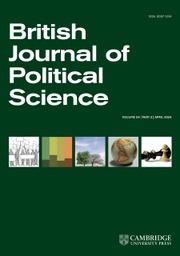Article contents
How Different are Telephoning and Canvassing? Results from a ‘Get Out the Vote’ Field Experiment in the British 2005 General Election
Published online by Cambridge University Press: 13 May 2008
Abstract
Information
- Type
- Notes and Comments
- Information
- Copyright
- Copyright © Cambridge University Press 2008
Footnotes
The authors wish to thank the University of Manchester and the McDougall Trust, which funded the project. They also wish to thank the research students who carried out the canvassing and Vision 22 for the telephone survey. The comments and support of colleagues at Manchester and from Don Green at Yale have been greatly appreciated. Helpful points were made at a panel on the experimental method in political science at the Annual Meeting of the American Political Science Association, Philadelphia, 2006.
References
1 Kevin Arceneaux, ‘Using Cluster Randomized Field Experiments to Study Voting Behavior’, Annals of the American Academy of Political and Social Science, 601, Special Issue, edited by Donald P. Green and Alan S. Gerber, The Science of Voter Mobilization (2005), 169–79; Bennion, Elizabeth A., ‘Caught in the Ground Wars: Mobilizing Voters during a Competitive Congressional Campaign’, Annals AAPSS, 601, Special Issue (2005), 123–4110.1177/0002716205277863CrossRefGoogle Scholar; Gerber, Alan S. and Green, Donald P., ‘The Effects of Canvassing, Direct Mail, and Telephone Contact on Voter Turnout: A Field Experiment’, American Political Science Review, 94 (2000), 653–63CrossRefGoogle Scholar; Gerber, Alan S. and Green, Donald P., ‘The Effect of a Nonpartisan Get-Out-the-Vote Drive: An Experimental Study of Leafleting’, Journal of Politics, 62 (2000), 846–57CrossRefGoogle Scholar; Gerber, Alan. S. and Green, Donald P., ‘Do Phone Calls Increase Voter Turnout? A Field Experiment’, Public Opinion Quarterly, 65 (2001), 75–8510.1086/320038CrossRefGoogle ScholarPubMed; Gerber, Alan S. and Green, Donald P., ‘Do Phone Calls Increase Voter Turnout? An Update’, Annals AAPSS, 601, Special Issue (2005), 142–5410.1177/0002716205278445CrossRefGoogle Scholar; Gerber, Alan S., Green, Donald P. and Green, Matthew N., ‘The Effects of Partisan Direct Mail on Voter Turnout’, Electoral Studies, 22 (2003), 563–79CrossRefGoogle Scholar; Green, Donald P., ‘Mobilizing African-Americans Using Direct Mail and Commercial Phone Banks: A Field Experiment’, Political Research Quarterly, 57 (2004), 245–55CrossRefGoogle Scholar; Green, Donald P., Gerber, Alan S. and Nickerson, David W., ‘Getting Out the Vote in Local Elections: Results from Six Door-to-door Canvassing Experiments’, Journal of Politics, 65 (2003), 1083–9610.1111/1468-2508.t01-1-00126CrossRefGoogle Scholar; Green, Donald P. and Shachar, Ron, ‘Habit Formation and Political Behaviour: Evidence of Consuetude in Voter Turnout’, British Journal of Political Science, 30 (2000), 561–73CrossRefGoogle Scholar; Michelson, Melissa R., ‘Meeting the Challenge of Latino Voter Mobilization’, Annals AAPSS, 601, Special Issue (2005), 85–101CrossRefGoogle Scholar; McNulty, John E., ‘Phone-Based GOTV – What's on the Line? Field Experiments with Varied Partisan Components, 2002–2003’, Annals AAPSS, 601, Special Issue (2005), 41–6510.1177/0002716205278176CrossRefGoogle Scholar; Nickerson, David, ‘Volunteer Phone Calls Can Increase Turnout’, American Politics Research, 34 (2006), 271–92CrossRefGoogle Scholar; Ramirez, Ricardo, ‘Giving Voice to Latino Voters: A Field Experiment on the Effectiveness of a National Nonpartisan Mobilization Effort’, Annals AAPSS, 601, Special Issue (2005), 66–84CrossRefGoogle Scholar; Trivedi, Neema, ‘The Effect of Identity-Based GOTV Direct Mail Appeals on the Turnout of Indian Americans’, Annals AAPSS, 601, Special Issue (2005), 115–22CrossRefGoogle Scholar; Wong, Janelle S., ‘Mobilizing Asian American Voters: A Field Experiment’, Annals AAPSS, 601, Special Issue (2005), 102–14CrossRefGoogle Scholar. Many of these studies are summarized in Green, Donald P. and Gerber, Alan S., Get Out The Vote: How to Increase Voter Turnout (Washington, D.C.: The Brookings Institution, 2004)Google Scholar.
2 The main non-US study is Guan, Mei and Green, Donald P., ‘Noncoercive Mobilization in State-Controlled Elections: An Experimental Study in Beijing’, Comparative Political Studies, 39 (2006), 1175–9310.1177/0010414005284377CrossRefGoogle Scholar.
3 The Electoral Commission funds projects involving voter mobilization at the community level, see Electoral Commission, New Initiatives Fund: Information for Prospective Applicants (London: Electoral Commission, 2003).
4 Bochel, J. M. and Denver, David, ‘Canvassing, Turnout and Party Support: An Experiment’, British Journal of Political Science, 1 (1971), 257–69.10.1017/S000712340000911XCrossRefGoogle Scholar
5 Gerber and Green, ‘The Effects of Canvassing, Direct Mail and Telephone Contact on Voter Turnout’.
6 The randomization was carried out using Microsoft Excel.
7 Gerber and Green, ‘The Effects of Canvassing, Direct Mail and Telephone Contact on Voter Turnout’.
8 Gerber and Green, ‘The Effects of Canvassing, Direct Mail and Telephone Contact on Voter Turnout’, pp. 65–8.
9 Callbacks were made for 21.7 per cent of the sample, with a small number (0.2 per cent) receiving a second visit.
10 Telephone calls took place between 3 p.m. and 8 p.m. each evening.
11 There are similar proportions of registered deceased in the canvassing and telephone groups at 1.2 and 1.3 per cent respectively.
12 These regulations have now been amended, ensuring that in future elections such records will be kept and will be available to consult.
13 Note that this would need to be done in a manner that avoids having the telephone actually ringing.
14 Nickerson, David W., ‘Scalable Protocols Offer Efficient Design for Field Experiments’, Political Analysis, 13 (2005), 233–5210.1093/pan/mpi015CrossRefGoogle Scholar.
15 Nickerson, ‘Scalable Protocols Offer Efficient Design for Field Experiments’.
16 Gerber and Green, ‘The Effects of Canvassing, Direct Mail and Telephone Contact on Voter Turnout’, pp. 657–8.
17 Green, Gerber and Nickerson, ‘Getting Out the Vote in Local Elections’, p. 1085.
18 Imai, Kosuke, ‘Do Get-Out-the-Vote Calls Reduce Turnout? The Importance of Statistical Methods for Field Experiments’, American Political Science Review, 99 (2005), 283–30010.1017/S0003055405051658CrossRefGoogle Scholar.
19 Gerber, Alan S. and Green, Donald P., ‘Correction to Gerber and Green (2000): Replication of Disputed Findings and Reply to Imai (2005)’, American Political Science Review, 99 (2005), 301–1310.1017/S000305540505166XCrossRefGoogle Scholar.
20 Gerber and Green, ‘The Effects of Canvassing, Direct Mail and Telephone Contact on Voter Turnout’, p. 657.
21 Nickerson, ‘Volunteer Phone Calls Can Increase Turnout’, p. 283.
22 Nickerson, ‘Volunteer Phone Calls Can Increase Turnout’, p. 283.
- 50
- Cited by

